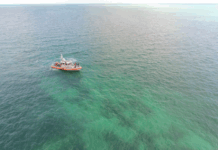
Starfish, or sea stars, are iconic marine animals often found in tide pools, along the shoreline, in seagrass beds and mangrove channels. Their unique appearance and vibrant colors make them an irresistible photo subject for snorkelers and beachgoers.
What many people don’t realize is that removing starfish from the water — even briefly — can cause them serious harm and, in many cases, lead to their death.
Unlike fish, starfish do not have gills. They breathe through small structures called papulae, or skin gills, which absorb oxygen directly from the water. When a starfish is taken out of its aquatic environment, these structures collapse and can no longer function properly. Deprived of oxygen, the animal begins to suffocate almost immediately. Because starfish don’t have lungs, they can’t “hold their breath” when out of the water. Even short exposures to air can cause stress and internal damage, especially in hot or dry conditions.
Starfish have a fragile, hydraulic vascular system that controls movement through water pressure. Lifting them or placing them on a dry surface can disrupt this system. In some cases, handling causes irreversible internal injuries, even if the starfish appears fine initially. The rough texture of a starfish may give the illusion of toughness, but they are delicate creatures. Oils, sunscreen, or even the heat from human hands can irritate their outer layers and compromise their health.
Many marine animals, including starfish, are highly sensitive to environmental changes. When removed from water, they experience a spike in stress, which can lead to shock or disorientation. Some species of starfish are especially vulnerable and may die hours or days after being returned to the sea, even if they seemed unharmed at the time of handling.
In popular tourist areas, it’s not uncommon for dozens of starfish to die after being collected for photos and left out in the sun. Social media trends encouraging photos with sea life have inadvertently contributed to mass mortality events. Starfish that are piled up for photos or souvenirs often cannot recover, even if they are placed back in the water afterward.
The best way to appreciate starfish is to observe them in their natural habitat without touching them. Many marine conservationists urge people to follow a “look, don’t touch” policy. Not only does this protect sea life, but it also preserves ecosystems for future generations.
If you find a starfish washed ashore, it may already be dead, but not always. If it’s soft, flexible, or moving slightly, it’s still alive and should be returned gently to the water without flipping or dropping it. Always use wet hands or gloves if contact is absolutely necessary.
While it might seem harmless to pick up a starfish for a quick picture, doing so can cause serious and often fatal consequences for the animal. Respecting marine life means keeping it in the water where it belongs. Next time you’re snorkeling, bring an underwater camera, take a photo of a starfish in its natural setting, and leave it just as you found it. Nature’s beauty is best enjoyed without causing harm.





















